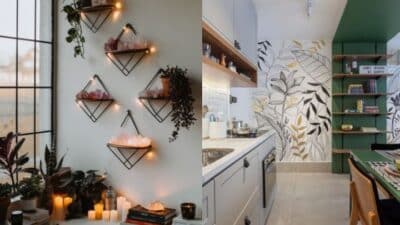DIY shelves are a practical way to add storage and style to your home without breaking the bank. Whether you want to display books, organize your kitchen, or make use of small spaces, building shelves yourself allows you to create custom solutions that fit your needs. You can build functional shelves with basic tools, simple materials, and a clear plan, even if you have little woodworking experience.
There are many types of DIY shelves, from classic floating shelves to corner units and upcycled designs. The variety of materials and styles means you can match new shelving to your space and personal taste with ease. With the right approach, you’ll get shelves that look professional and last for years.
Key Takeaways
- Learn the tools, materials, and planning needed for DIY shelves.
- Discover different shelf types and follow step-by-step instructions.
- Finish and style your shelves for practical and attractive results.


Essential Tools and Materials
Reliable tools, the right type of wood, and appropriate hardware are all crucial for building durable and attractive DIY shelves. Paying attention to these details will save you time and help ensure your shelves are secure and long-lasting.
Must-Have Tools
For accurate cutting and assembly, start with a quality measuring tape to ensure all pieces fit as planned. You will need a circular saw or table saw for ripping larger sheets of plywood and making straight cuts in lumber. A miter saw helps with precise angled cuts, especially for trim or shelf supports.
A solid drill or impact driver makes driving wood screws straightforward. Good jigs can help with consistent screw placement and measuring repeated cuts. Have clamps on hand to hold pieces steady when gluing or screwing boards together. Sanding is necessary for a smooth finish—use either a sanding block or an orbital sander for efficiency.
Here’s a quick summary:
| Tool | Use |
|---|---|
| Measuring tape | Marking and precision |
| Circular saw | Straight cuts, sheet goods |
| Table saw | Long, straight cuts |
| Miter saw | Angle cuts |
| Drill/Driver | Inserting screws or anchors |
| Jigs/Clamps | Repeat accuracy, stability |
| Sander | Surface smoothing |
Choosing the Right Wood
Selecting the right wood impacts the strength, appearance, and cost of your shelves. For utility shelves, plywood is affordable, sturdy, and resists warping. Lumber like pine or fir is common for framing or basic shelving. If you want a clean, high-end look, consider hardwoods such as oak, maple, or walnut, but expect higher prices.
Thickness matters: For most shelves, 3/4-inch plywood or solid wood strikes a good balance between strength and weight. Avoid thin boards that can sag under load. Check for knots, warping, and defects before purchasing any wood.
Buy enough material for both the shelves and supports. Bringing a cut list and measurements when shopping helps prevent errors and extra trips.
Hardware Selection
Quality hardware ensures your shelves stay secure. Use wood screws for most shelf construction—choose lengths that penetrate at least halfway through the boards being joined. For mounting shelves to the wall, use sturdy shelf brackets or floating hardware depending on your design.
Wall anchors are necessary when you can’t drill directly into a wall stud. Choose anchors rated for the expected load. For extra strength, apply wood glue along joint surfaces before fastening with screws.
Consider finish options too: zinc-plated or stainless steel screws resist corrosion, and decorative bracket styles can complement your room’s design. Always match your hardware’s size and type to the weight and function of your shelves.


Planning Your DIY Shelves Project
Accurate planning is essential for a sturdy and functional shelving system. Success relies on careful measurements, smart spacing, and picking the right spot in your home.
Measuring and Layout
Start by gathering tools such as a measuring tape, pencil, and level. Precise measurements are essential to ensure your shelves fit the intended space and can hold the items you need them to.
Measure the wall height and width where you plan to install the shelves. Mark the dimensions on the wall lightly with a pencil. A level ensures your shelf lines are straight and even. Always double-check measurements before making any cuts or drilling.
Sketch a basic layout on paper, including shelf lengths and heights. For uneven walls, take measurements at multiple points to identify any variations.
Determining Spacing
Proper shelf spacing depends on what you intend to store. For books, allow 10-12 inches between shelves. For general storage, 12-16 inches is common.
Use the following table for reference:
| Item Type | Recommended Shelf Spacing |
|---|---|
| Books | 10-12 inches |
| Bins/Baskets | 14-18 inches |
| Decorative Items | 10-15 inches |
Use a stud finder to locate wall studs for support, especially for heavier items. Mark the shelves’ positions on the wall before installation. Adjust spacing to avoid blocking outlets, switches, or windows.
Choosing the Shelf Location
Examine the wall or area where the shelves will go. Evaluate factors such as sunlight, humidity, and proximity to doors or windows to prevent warping or item damage.
Check for the presence of studs behind the wall using a stud finder. Securing your shelves to studs increases load capacity. For drywall, use proper anchors if studs aren’t available.
Consider the flow of the room—shelves should not obstruct walkways or create hazards. Wall corners and alcoves often offer efficient use of space for additional storage. Think about visual balance and how the new shelves fit with other furniture in the room.


Types of DIY Shelves
DIY shelving options are diverse, allowing you to pick a style that suits your wall structure, storage needs, and aesthetic preferences. Some designs emphasize minimalism and concealment, while others provide visible support or maximize strength with built-in features.
Floating Shelves
Floating shelves appear to “float” on the wall by hiding their support hardware. You achieve this effect by mounting special brackets or cleats inside the shelf, then securing them to wall studs. These shelves offer a clean, modern look and are ideal for displaying books, photos, or decorative objects.
You should use sturdy materials like solid wood or plywood for your floating shelves. Wall anchors or strong mounting points are essential since the weight is supported by hidden attachments. Floating shelves typically require more precise installation compared to other styles.
Carefully measure stud spacing and consider shelf depth before cutting. These shelves work especially well in living rooms, bathrooms, or kitchens, where they add surface space without visible brackets or hardware.
Bracket Shelves
Bracket shelves are supported by visible shelf brackets attached to the wall. You will find brackets made from metal, wood, or plastic in a wide variety of styles, from utilitarian to decorative. This design makes installation straightforward and provides solid structural support for heavier loads.
To install, fasten the brackets directly to wall studs or use heavy-duty anchors for drywall applications. The exposed brackets can become a part of your décor, offering both function and ornamentation. You can pair simple plywood or reclaimed wood shelves with classic L-brackets for a low-cost approach.
A list of bracket types you may encounter:
- L-shaped metal brackets
- Decorative wood brackets
- Adjustable wall tracks with moveable supports
This type is especially useful in garages, workshops, or pantries, where shelf stability is a priority and you don’t mind exposed supports.
Cleat-Supported Shelves
Cleat-supported shelves rely on wooden cleats fastened to the wall to hold up the shelf boards. You install horizontal strips (cleats) under the back edge and sometimes the sides of the shelf. This method locks the shelf in place and distributes weight evenly along the wall.
Cleats are typically cut from 1×2 or 2×2 lumber and anchored to studs for maximum strength. After securing cleats to the wall, you simply rest or fasten the shelf on top. This design is excellent for utility rooms or closets, and for shelving that needs to hold significant weight.
You gain a sturdy, built-in appearance, but the cleats remain partially visible below or beside the shelf. Consider painting or finishing the cleats to match the shelf or wall color for a more integrated effect.


Step-by-Step Building Process
Start by preparing all the materials needed for your shelves. Using the right tools and mounting techniques ensures that your shelves are stable, level, and capable of supporting the intended weight.
Cutting and Preparing Materials
Measure and mark the lengths for your shelf boards, supports, and trim using a tape measure and pencil. Accuracy at this stage is crucial to ensure everything fits together neatly.
For straight cuts, use a circular saw or table saw. If you need angled or precise crosscuts, a miter saw is useful. Check that the ends are smooth and even—sand any rough edges before assembly.
Thoroughly inspect each piece for warping or damage. Pre-drill holes where screws will go to avoid splitting the wood later. Lay out your materials in the order of assembly for easy access.
Shelf Assembly
Arrange the boards and supports according to your design on a flat surface. Apply wood glue along the edges where the boards meet to improve stability.
Secure the boards together using screws, driving them into pre-drilled holes. Use a drill with a bit slightly smaller than your screws for the best hold. Wipe away any excess glue with a damp rag.
Once assembled, check the shelf for squareness and adjust as needed. Attach any front trim or edging for a finished look. Let the glue dry fully before continuing to the installation.
Wall Mounting Methods
Locate wall studs with a stud finder before mounting the shelves. Mark the spots clearly for proper alignment.
Choose a mounting method that suits your wall type. For drywall, use wall anchors to provide extra support. For solid walls, heavy-duty screws or toggle bolts are effective. Fasten the shelf supports directly into wall studs whenever possible.
Use a level to make sure each shelf sits straight. Drill pilot holes and carefully secure the supports. Once all supports are attached, set the shelf on top and fix it in place with additional screws.
Shelf Support and Reinforcement
Use sturdy shelf brackets or cleats underneath each shelf to distribute weight evenly. Metal or solid wood supports generally offer greater strength for heavy loads.
For longer shelves, consider adding a center support to prevent sagging. Reinforce all joints with wood glue and double screws if the shelf will carry significant weight.
Double-check the tightness of all screws and the integrity of the supports before loading the shelves. Test stability by gently pressing down on the shelf and adjusting as needed. Proper reinforcement ensures your shelf remains safe and functional over time.


Finishing and Styling Your Shelves
The right finishing touches can enhance both the look and longevity of your DIY shelves. Preparing and styling your shelves well ensures they are both functional and attractive for any area of your home.
Sanding and Staining
Start by sanding every surface of your shelves. Use a medium-grit sandpaper (around 120 grit) for initial smoothing, then move to a finer grit (180-220) for a clean finish. Pay close attention to edges and corners to avoid splinters.
After sanding, wipe down the shelves with a slightly damp cloth to remove dust. For staining, select a wood stain that matches your desired color and apply it evenly with a brush or cloth. Let the stain soak in for several minutes, then wipe away any excess.
Allow the shelves to dry completely before applying a clear coat or polyurethane for protection. This will enhance durability and help preserve the wood’s look. Between coats, gently sand with very fine sandpaper for the smoothest result.
Painting Techniques
If you choose to paint your shelves, begin with a primer suited for your shelf material. This helps the paint adhere better and gives a more even finish. Apply a thin, even coat of paint using a high-density foam roller for flat surfaces and a brush for corners.
Wait for the first coat to dry, then lightly sand to remove any brush marks or imperfections. Apply a second coat for solid coverage. If you want a smoother, professional look, consider sanding lightly again between coats.
For a unique finish, try distressing, color blocking, or a two-tone effect. Use painter’s tape for sharp edges or patterns. Always allow the paint to dry thoroughly before handling or installing the shelves.
Final Installation Tips
Install brackets and fasteners that are appropriate for the shelf size and wall type. Use a level to ensure your shelves are perfectly straight before securing them. Mark anchor points on the wall and pre-drill holes if necessary.
Secure shelves using wall anchors for added strength, especially for drywall. Double-check that everything is tightly attached, and give the shelves a gentle shake to confirm stability.
Align multiple shelves with a tape measure and level to maintain even spacing. If your shelves will hold heavy items, distribute the weight evenly and check occasionally for any loosening.
Styling Ideas
Arrange items in a mix of vertical and horizontal groups to add interest. Use a combination of books, decorative objects, plants, and framed photos, staggering heights for balance. Stack books both upright and on their sides.
Add baskets or boxes for organization and texture. Leave some space between groups of items for an uncluttered feel. Incorporate natural accents, such as small vases or terracotta pots, for added warmth.
Use a cohesive color palette that complements your room. Layer objects by placing smaller items in front of larger ones. Adjust your arrangement until the shelves feel balanced and visually pleasing.
- 1.6Kshares
- Facebook0
- Pinterest1.6K
- Twitter0



